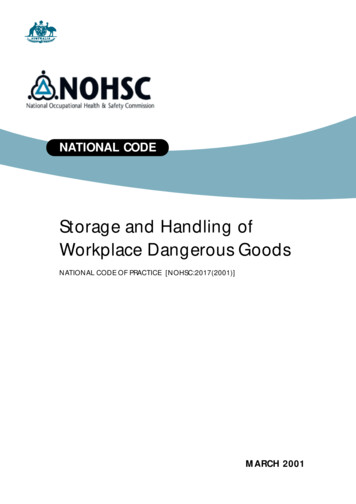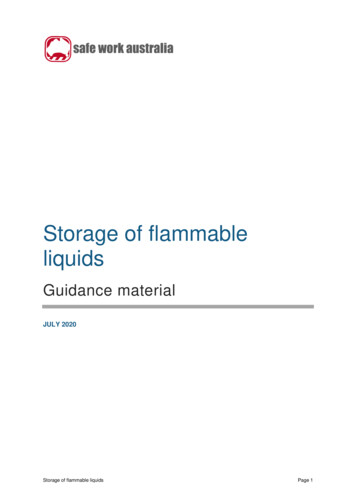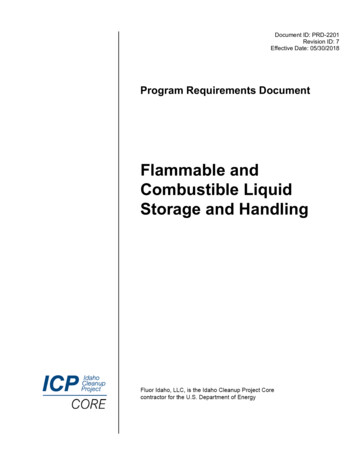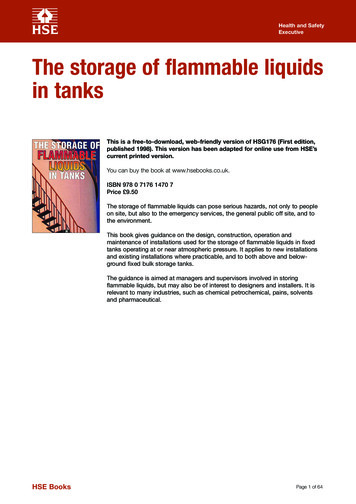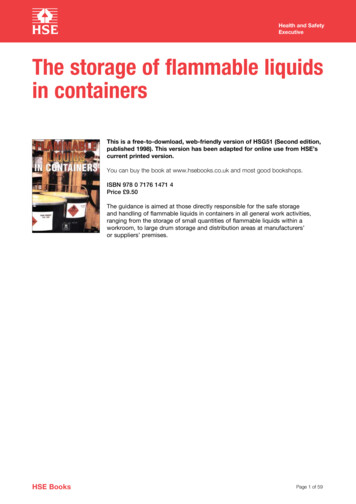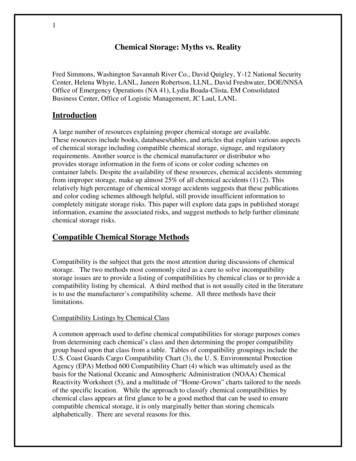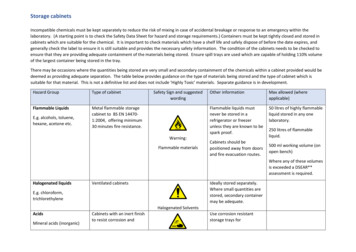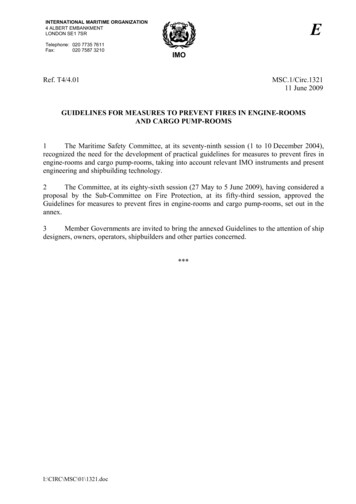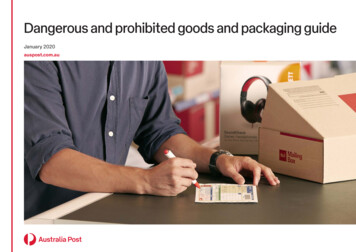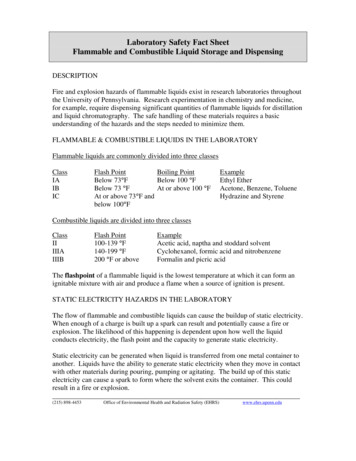
Transcription
Laboratory Safety Fact SheetFlammable and Combustible Liquid Storage and DispensingDESCRIPTIONFire and explosion hazards of flammable liquids exist in research laboratories throughoutthe University of Pennsylvania. Research experimentation in chemistry and medicine,for example, require dispensing significant quantities of flammable liquids for distillationand liquid chromatography. The safe handling of these materials requires a basicunderstanding of the hazards and the steps needed to minimize them.FLAMMABLE & COMBUSTIBLE LIQUIDS IN THE LABORATORYFlammable liquids are commonly divided into three classesClassIAIBICFlash PointBoiling PointBelow 73 FBelow 100 FBelow 73 FAt or above 100 FAt or above 73 F andbelow 100 FExampleEthyl EtherAcetone, Benzene, TolueneHydrazine and StyreneCombustible liquids are divided into three classesClassIIIIIAIIIBFlash Point100-139 F140-199 F200 F or aboveExampleAcetic acid, naptha and stoddard solventCyclohexanol, formic acid and nitrobenzeneFormalin and picric acidThe flashpoint of a flammable liquid is the lowest temperature at which it can form anignitable mixture with air and produce a flame when a source of ignition is present.STATIC ELECTRICITY HAZARDS IN THE LABORATORYThe flow of flammable and combustible liquids can cause the buildup of static electricity.When enough of a charge is built up a spark can result and potentially cause a fire orexplosion. The likelihood of this happening is dependent upon how well the liquidconducts electricity, the flash point and the capacity to generate static electricity.Static electricity can be generated when liquid is transferred from one metal container toanother. Liquids have the ability to generate static electricity when they move in contactwith other materials during pouring, pumping or agitating. The build up of this staticelectricity can cause a spark to form where the solvent exits the container. This couldresult in a fire or explosion.(215) 898-4453Office of Environmental Health and Radiation Safety (EHRS)www.ehrs.upenn.edu
PROCEDURES TO AVOID STATIC ELECTRICITYTo avoid the build up of static electricity that may cause a spark, it is important to bondand ground metal or special conductive plastic containers. Bonding eliminates theelectrical potential between two containers therefore eliminating the likelihood of sparks.A bonding wire is connected to two conductive objects as seen in the drums picturedbelow.Bonding wires between drumsGrounding eliminates the difference in static potential charge between the conductiveobject and ground. Grounding is accomplished by connecting the conductive objectdirectly to the earth, usually using cold water copper pipes, building steel or groundingbus/bar.Building Static Grounding “Bus”(Mounted on Wall)Small GroundingClamp AttachedSmallGroundingto PortableSolventAttachedContainer ToClampCable ofSufficientLengthPortable Containerwww.ehrs.upenn.edu(215) 898-4453Office of Environmental Health and Radiation Safety (EHRS)
Bonding and grounding require good electrical connections. Remove any dirt, paint orrust ensuring metal to metal contact.Bonding and Grounding wires come in a variety of styles and lengths. They can bepurchased through Fisher Scientific:, Justrite Manufacturing: and through Lab SafetySupply:Hand Clamp‘C’ Clamp and Alligator ClipStatic hazards may also exist in non-metallic plastic or glass containers that cannot begrounded. Static may be generated by the free fall and turbulence of the liquid beingpoured. To minimize this hazard, pour as slowly as possible and use a grounded nozzleextension that allows filling the container from the bottom.DISPENSING FLAMMABLE LIQUIDS FROM 5 GALLON PAILSManual dispensing pumps for 5-gallon pails/cans are available. These pumps arespecifically designed to dispense liquids into small laboratory-size bottles withoutspilling. If you are pouring into a conductive container, a bonding wire should beattached from the 5-gallon pail to the container being filled. The 5-gallon pail should begrounded.The dispenser shown in the picture below can be purchased through Fisher ScientificThe metal strap in the picture hooks over the bottom of the pail and secures the dispenserwhile pumping.(215) 898-4453Office of Environmental Health and Radiation Safety (EHRS)www.ehrs.upenn.edu
Metal StrapDISPENSING FLAMMABLES FROM SAFETY CANSSafety cans have self-closing air tight lids and a flame arrester that protects the contentsfrom an external ignition source. Bonding and grounding is still required on safety canssince static electricity generation is possible. The nozzle provides a bonding path to areceiving metallic vessel.If either of the containers are non-metallic (conductive) it is still important to follow thelimited velocity and grounded nozzle extension information given previously.Safety can withextended nozzle(215) 898-4453Office of Environmental Health and Radiation Safety (EHRS)www.ehrs.upenn.edu
Safety cans do not offer protection from heat when exposed to fire and should be storedin a flammable liquids storage cabinet when not in use.FLAMMABLE LIQUIDS STORAGE CABINETSIn most university laboratories flammable liquids storage is provided under the chemicalfume hood in specifically designed vented cabinets. These cabinets are clearly marked“Flammable Storage”. Flammable liquids storage cabinets are constructed to limit theinternal temperature when exposed to fire. When additional storage is needed, NFPA 304.3.3 approved flammable liquids storage cabinet (FLSC) may be purchased. Allcontainers of flammable liquids must be stored in a FLSC when not in use. Thefollowing requirements apply:General RequirementsCabinets shall be no larger than 45 gallon capacityCabinets should be located near fume hood alcovesCabinets shall be marked “Flammable-Keep Fire Away”Biomedical LaboratoriesFree standing cabinets in biomedical labs shall not be vented. Bungs shall be used to sealvent openings.Physical Science LaboratoriesFree standing cabinets may be vented into the fume hood exhaust system or a dedicatedsystem for hazardous materials exhaust if present. Replacement air shall be ducted intothe cabinet in such a way as not to compromise the specified performance of the cabinet.Venting details shall be submitted to the offices of Environmental Health and RadiationSafety and University Architect for approval.Grounding of Flammable Liquids Storage CabinetsFlammable liquids storage cabinets are equipped with a grounding system that can beconnected to a building ground. If you are pouring from a container in the storagecabinet and if the container being poured to is conductive then a bonding strap should beattached between them as explained in ‘PROCEDURES TO AVOID STATICELECTRICITY’ found above.Fisher Scientific and Grainger carry a wide variety of flammable liquids storage cabinets.(215) 898-4453Office of Environmental Health and Radiation Safety (EHRS)www.ehrs.upenn.edu
PERSONAL PROTECTIVE EQUIPMENTSplash proof goggles in addition to standard laboratory personal protective equipment(PPE) consisting of a lab coat, closed toe shoes and nitrile gloves should be worn whilepouring flammable liquids. Pouring larger volumes may require additional PPEconsisting of thicker gloves and an apron. Follow your laboratory Standard OperatingProcedures (SOP).EMERGENCY PROCEDURESIn the case of a fire, call 511 from a university phone to reach Police/Fire, pull the firealarm and leave the building. Make yourself available to the emergency responders.Follow your laboratory specific SOP for emergencies.An eyewash/safety shower must be nearby when dispensing flammable liquids.(215) 898-4453Office of Environmental Health and Radiation Safety (EHRS)www.ehrs.upenn.edu
4.3.3 approved flammable liquids storage cabinet (FLSC) may be purchased. All containers of flammable liquids must be stored in a FLSC when not in use. The . Fisher Scientific and Grainger carry a wide variety of flammable liquids storage cabinets. _ (215) 898-4453 Office of Environmental Health and Radiation Safety (EHRS) www.ehrs.upenn .
